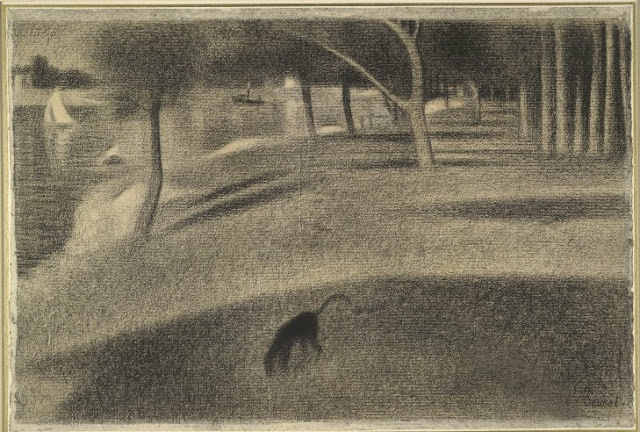 |
| Georges Seurat Study for La Grande Jatte 1884 drawing British Museum |
 |
| Georges Seurat Woman fishing - study for La Grande Jatte 1884 drawing Metropolitan Museum of Art, New York |
 |
| Georges Seurat Madame Seurat, the artist's Mother ca. 1882-83 drawing Getty Museum, Los Angeles |
"And as for Seurat's drawings! Seurat's abstractness, hieratism, and naive cursiveness of edge . . ."
"Where in Seurat can one find two figures facing one another, let alone conversing?"
 |
| Georges Seurat Woman Strolling (Une élégante) ca. 1884 drawing Getty Museum, Los Angeles |
 |
| Georges Seurat Study for Poseuses 1886-87 drawing Metropolitan Museum of Art, New York |
 |
| Georges Seurat Study for Une baignade 1883 drawing National Gallery of Scotland, Edinburgh |
"All the aesthetic categories of the nineteenth century, including most of the modernist ones, disappeared down the black hole of Seurat's technique. A technique that pretended to be a technics – to engineer at last the "elocutory disappearance of the poet, who cedes the initiative to words – [Mallarmé]".
 |
| Geroges Seurat Lighthouse at Honfleur 1886 drawing Metropolitan Museum of Art, New York |
 |
| Georges Seurat Poplars 1883-84 drawing Getty Museum, Los Angeles |
 |
| Georges Seurat Nurse with child's carriage ca. 1882-84 drawing Morgan Library, New York |
"In Seurat, those moments collapsed into one another – they were equated, or duplicated, or ironized out of existence. Drawing (that is, separate identities) emerged from the wreckage as so much whispering of ghosts. Ghosts of an endless, ignominious energy. But not people – not objects of empathy or sympathy. Not actors. Not things with insides."
 |
| Georges Seurat The black bow ca. 1882 drawing Musée d'Orsay, Paris |
 |
| Georges Seurat Landscape with houses 1881-82 drawing Metropolitan Museum of Art, New York |
 |
| Georges Seurat Peasants ca. 1881-84 drawing Metropolitan Museum of Art, New York |
"Seurat was profoundly anarchism's painter: cruel and elusive and infinitely fond of the city's foibles and moments of freedom. He operated at the point where an all-consuming aesthetic irony happens on a truly naive delight in other people. Where negation is indistinguishable from utopia."
 |
| Georges Seurat Courbevoie - Factories by moonlight 1882-83 drawing Metropolitan Museum of Art, New York |
 |
| Georges Seurat Portrait of Paul Signac 1890 drawing private collection |
– quoted passages are by T.J. Clark from his chapter on Camille Pissarro and anarchism in Farewell to an Idea: Episodes from a History of Modernism (Yale University Press, 1999)